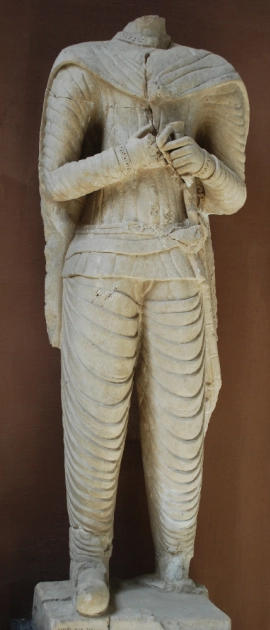Amazon Audible Gift Memberships

Try Amazon Audible Plus
Statue of a Parthian Man: Makai ben Nashri, Hatra, 1st and 2nd centuries AD.
Mosul Museum, Iraq.

A larger image of the Statue of a Parthian Man: Makai ben Nashri, Hatra, 1st and 2nd centuries AD. Mosul Museum, Iraq.
Headless statue, clutching a sword in his hands and wearing long pleated trousers and a cape.
An inscription identifies it as a depiction of a certain Makai ben Nashri. Photo by Diane Siebrandt, U.S. State Department, 2008.
Source: Gates of Nineveh
Fig. 18 The statue of Makai ben Nashri (Source: Photo by Diane Siebrandt, U.S. State Department, 2008).
The features of the legwear and footwear are also well preserved, leading to further questions.
A curious feature of the Andika nobleman is the ‘folds’ on the lower part of his ‘trousers’ which are visible from the knees to the ankles just above the footwear.
While it is possible to argue that the ‘folds’ on the trousers are actually metallic laminated leg armor/guards,
the authors hypothesize that the trousers are probably of the folded type (perhaps like the chaps worn by modern-day cowboys in North America).
This type of chaps-attire is seen with the statue of the Susa nobleman (housed at the Iran Bastan Museum) (Figure 17)
as well as the statues of the noblemen at Hatra like that of Makai ben Nashri (Figure 18).
The challenge against this hypothesis is the question of the upper portion of the Andika nobleman’s trousers:
is the relief showing further extension of various layers of overlapping clothing from the tunic (thus extending to the knees like the
Persepolis graffiti)
or is the clothing seen at the upper thigh areas part of the (upper) trousers?
It is possible that the tunic has a ‘curtain’ type opening beginning just below the belt area, allowing for the display of the upper part of the trousers.
If this is the case, then it is challenging to explain as to why the ‘chap’-like (or laminated-like) folds only appear at the lower legs and not at the upper.
Perhaps this is a local variation of Parthian trousers, as the use of laminated leg armor for the lower legs (only)
is not militarily functional and not seen in any known depictions of Parthian costumes.
Thus the Andika nobleman’s leg wear may be indicative of a hitherto unknown type of design.
p. 47, "Preliminary reports of the late Parthian or early Sassanian relief at Panj-e Ali, the Parthian relief at Andika and examinations of late Parthian swords and daggers" by Farrokh et al.
See also Effigy of a Parthian Man, Iran, 1st–2nd century AD, Susa Museum of Iran
Parthian relief of Mithridates 1st of Parthia at Xong-e Ashdar. City of Izeh, Khouzestan province, Iran.
Parthian horse-archer plaque, Syria, 1st Century BC-3rd Century AD
Seleucid or Parthian Cataphract and a Lion, Iraq, 3rd Century BC-2nd Century AD
Other Parthian Illustrations of Costume & Soldiers


